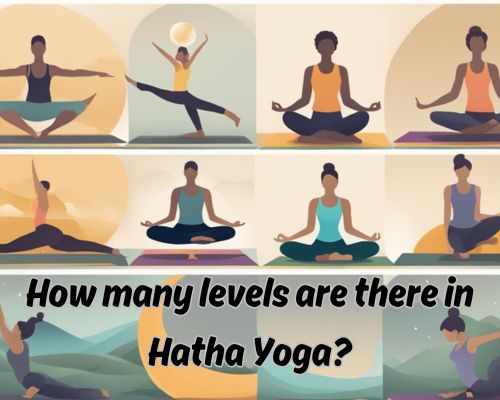Exploring the depths of Hatha Yoga leads practitioners on a transformative journey through both physical poses and spiritual development.
Traditional Hatha Yoga embodies several levels, each offering a pathway to more profound self-awareness and mastery.
At its core, Hatha Yoga traditionally features six levels: the practice of asanas, pranayama, pratyahara, dharana, dhyana, and samadhi.

These six elements are designed to cultivate a balanced state of body and mind, guiding individuals on a path of holistic well-being.
Asanas, being the physical postures, lay the groundwork, while pranayama, the breath control, further harmonises energy within.
Higher levels such as pranayama and dharana deepen the yoga practice by refining one’s focus and concentration, ultimately leading towards enlightenment, see https://bikramyogamornington.com.au/.
Foundations of Hatha Yoga
Hatha Yoga focuses on the integration of physical postures, breathing techniques, energy flow, and mental concentration.
This ancient practice offers pathways for improving physical strength and flexibility while nurturing mental calmness and inner balance.
Asanas and Physical Postures
In Hatha Yoga, asanas are essential as they form the foundation of physical practice.
Each posture is designed to enhance flexibility, strength, and alignment.
Practicing these yoga asanas encourages muscular and skeletal balance, supporting the body’s overall immunity and vital force.
The effective alignment of each asana ensures safe practice, maximising benefits while minimising injury risks.
Focus is required to maintain each posture, promoting mental concentration. Regular practice leads to increased relaxation and physical awareness.
Energy Channels and Flow
Central to Hatha Yoga is the concept of energy channels known as nadis.
These pathways facilitate the circulation of energy or prana throughout the body.
Balancing these energy channels is key for achieving inner peace and physical vitality.
Practitioners recognise certain locks or bandhas that aid in regulating this energy flow.
Engaging these bandhas can help awaken kundalini, the latent energy believed to reside at the base of the spine.
Proper channel management enhances overall wellness.
Breathing Techniques and Pranayama
Pranayama refers to the control and extension of breath, an integral component of Hatha Yoga.
Through specific breathing techniques, practitioners learn to regulate their breath, harmonising the mind and body.
This focus on breath control can improve circulation and oxygenation.
Pranayama exercises, such as alternate nostril breathing, support the energy balance and vital force within the body.
Regular practice can strengthen respiratory function and boost immunity, while also enhancing relaxation and focus. For practitioner’s expertise, see https://bikramyogamornington.com.au/
Meditation and Mental Focus
Meditation in Hatha Yoga cultivates mental focus and concentration, allowing practitioners to still the mind’s fluctuations.
This practice offers a pathway to inner tranquillity and self-awareness.
Meditation often precedes or follows physical techniques, reinforcing the connection between body and mind.
Attentiveness during meditation develops the mental clarity necessary for sustained practice.
With time, individuals can achieve deeper states of concentration and a profound sense of peace and unity.
Hatha Yoga Practice and Teaching
Hatha Yoga involves a holistic approach to physical, mental, and spiritual development.
Its practice focuses on postures, breath control, and meditation, aiming to harmonise the body and mind.
A teacher’s guidance is crucial for ensuring proper techniques and fostering self-awareness.
Structure of a Hatha Yoga Class
A typical Hatha yoga class usually begins with a warm-up to prepare the body.
This may be followed by a sequence of yoga asanas such as Mountain Pose and Tree Pose.
The session often concludes with relaxation or meditation.
Classes can include aspects like pranayama to connect breath with movement, aiming to balance energy levels.
Classes vary in intensity, from gentle to vigorous, allowing for different levels of practitioners.
Dhyana and dharana are often integrated to promote concentration and mindfulness.
This structure caters to both new and experienced students, ensuring accessibility and growth.
Emphasis on slow-paced and deliberate movements helps develop rajasic and sattvic qualities in practitioners.
Props and Adjustments
Props such as blocks, straps, and bolsters are common in Hatha Yoga classes.
They assist practitioners in achieving correct alignment and maintaining poses.
Instructors might use props to help students experience the full benefits of each asana, especially in Iyengar Yoga, known for its emphasis on precision and alignment.
Adjustments, both verbal and physical, are used to enhance a student’s practice.
Teachers may gently guide students into deeper poses or offer modifications for safety.
Props and adjustments help create a supported and adaptive environment, accommodating various skill levels and body types.
Paths to Enlightenment
Hatha Yoga is part of a broader spiritual practice, often linking to Raja Yoga and the pursuit of samadhi – a state of meditative absorption.
The Hatha Yoga Pradipika outlines practices involving mudras, mantras, and kriyas designed for spiritual growth and awakening of the chakras.
Practitioners aim to transcend the physical practice towards spiritual enlightenment.
The dualism in Hatha Yoga reflects a balance of opposites, embodied in the sun and moon energies (ha and tha).
Through consistent practice, individuals cultivate self-discipline and mindfulness, aligning physical exertion with spiritual pursuits.
The Role of a Yoga Teacher
A Hatha Yoga teacher plays a crucial role in guiding students through their practice. Teachers are responsible for creating a safe and supportive environment, where attention to individual needs is prioritised.
Through yoga teacher training, instructors gain knowledge of human anatomy, correct posture alignment, and effective communication.
Teachers inspire students to explore their edge while fostering self-awareness and mindfulness. They also ensure that the practice remains respectful of yoga’s classical traditions, offering insights into the philosophical aspects like pratyahara and non-dualism.
Students benefit significantly from their teacher’s understanding and passion, ensuring a rewarding and enriching yoga journey.
